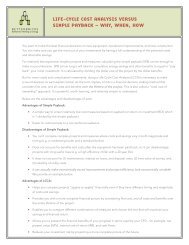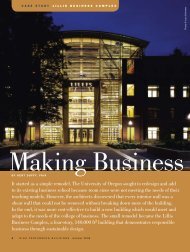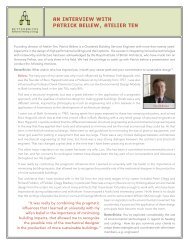Meeting the 2030 Challenge With integrated design - BetterBricks
Meeting the 2030 Challenge With integrated design - BetterBricks
Meeting the 2030 Challenge With integrated design - BetterBricks
Create successful ePaper yourself
Turn your PDF publications into a flip-book with our unique Google optimized e-Paper software.
While <strong>the</strong> search for syn<strong>the</strong>sis and new <strong>design</strong> solutions is less likely to<br />
happen when <strong>the</strong> members of a <strong>design</strong> team work in relative isolation,<br />
<strong>the</strong>y won’t necessarily be enhanced in project team meetings with broad<br />
agendas that must also meet <strong>the</strong> needs of non-<strong>design</strong>ers. Ensuring that<br />
activities such as goal setting, commissioning, and energy modeling are<br />
properly scheduled and receive <strong>the</strong> attention required by <strong>the</strong> team, will<br />
help to ensure a successful project and verify project performance, but<br />
significant breakthroughs in building energy performance will take place<br />
when <strong>the</strong> <strong>design</strong> process supports <strong>the</strong> search for syn<strong>the</strong>sis. Therefore it is<br />
recommended that <strong>the</strong>re ei<strong>the</strong>r be two sets of meetings, or two parts of each<br />
meeting: one for goal setting, process and management and ano<strong>the</strong>r for<br />
technical <strong>design</strong> solutions.<br />
There are critical points where <strong>the</strong> <strong>design</strong> process and <strong>the</strong> project schedule<br />
intersect, where proper coordination will provide distinct benefit. By<br />
scheduling certain tasks at particular times or in a given sequence, <strong>the</strong> project<br />
manager can facilitate a <strong>design</strong> that strives for increased performance. It’s<br />
also recommended that full team meetings be held at key points along <strong>the</strong><br />
project schedule to check on progress toward <strong>the</strong> goals.<br />
Michael Hatten, a mechanical engineer with SOLARC Architecture and Engineering, who has worked with Brown to<br />
advance <strong>the</strong> practice of <strong>integrated</strong> <strong>design</strong>, has observed <strong>the</strong> breakthroughs that can emerge from a project team’s<br />
exploration of new techniques.<br />
“Sometimes <strong>the</strong> past experience of a <strong>design</strong> team can become a barrier to new systems thinking. When a team is<br />
guided through those barriers by defining <strong>the</strong> effect of load reducing <strong>design</strong> strategies using modeling techniques, a<br />
conceptual awakening can happen. The “light bulb” comes on as folks realize that, once heating, cooling, and electric<br />
loads are moved into a new range, systems possibilities are greatly expanded. This is where building <strong>design</strong> becomes<br />
exciting: where <strong>the</strong> mechanical engineer and architect begin to collaborate on <strong>the</strong> <strong>design</strong> of external shading devices<br />
as a cooling system element of a building, and where <strong>the</strong> reality of achieving zero-energy performance in a building<br />
moves from an abstract dream to an achievable <strong>design</strong> goal.<br />
For example, <strong>the</strong> evaluation of load reducing <strong>design</strong> strategies in <strong>the</strong> high performance classroom, that ultimately<br />
inspired <strong>the</strong> classroom <strong>design</strong> at Mount Angel Abbey Academic Center in Oregon, indicated that it was possible to<br />
maintain occupant comfort without any conventional mechanical systems. Cooling season comfort was maintained by<br />
passive ventilation and internal <strong>the</strong>rmal mass. Heating season comfort was maintained by energizing electric lighting<br />
(or small electric heaters). In a very real <strong>integrated</strong> way, <strong>the</strong> heating and cooling systems were actually a syn<strong>the</strong>sis of<br />
envelope insulation, floor and ceiling mass, and daylighting strategies.”<br />
The Project Manager’s Role<br />
The role of <strong>the</strong> project manager is critical to <strong>the</strong> successful delivery of an <strong>integrated</strong> <strong>design</strong> process. A project manager<br />
can take very real steps to organize project roles and responsibilities to deliver <strong>integrated</strong> solutions that meet project<br />
performance goals. Such steps may include.<br />
• Train staff in <strong>the</strong> use of <strong>design</strong> tools and analytical techniques that help reveal synergistic opportunities<br />
between context, programming, and architectural and engineering <strong>design</strong>.<br />
• Assign individuals <strong>the</strong> responsibility for delivering <strong>integrated</strong> solutions or specific services. For example,<br />
ra<strong>the</strong>r than maintaining daylighting <strong>design</strong> and electric lighting as separate activities, task someone with an<br />
<strong>integrated</strong> lighting solution.<br />
<strong>Meeting</strong> <strong>the</strong> <strong>2030</strong> <strong>Challenge</strong> <strong>With</strong> Integrated Design<br />
3









